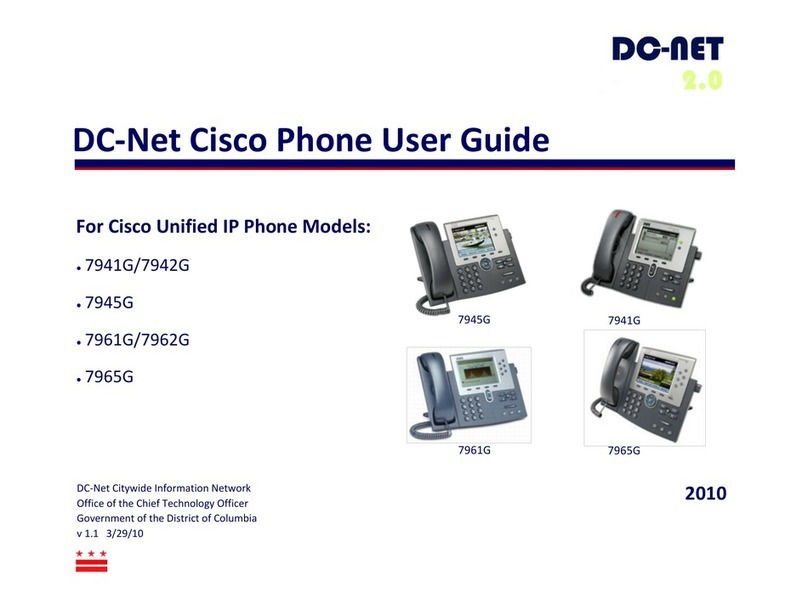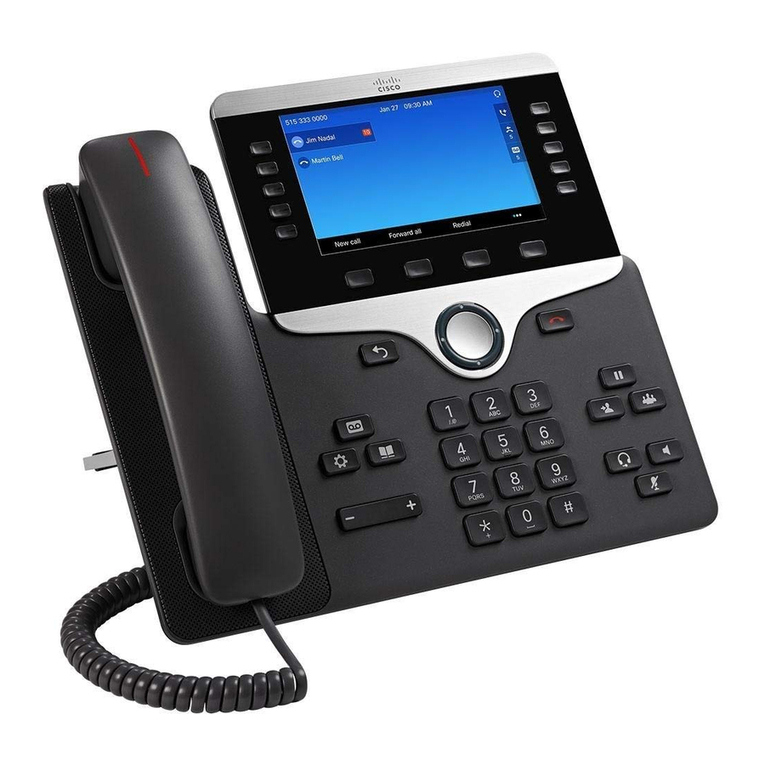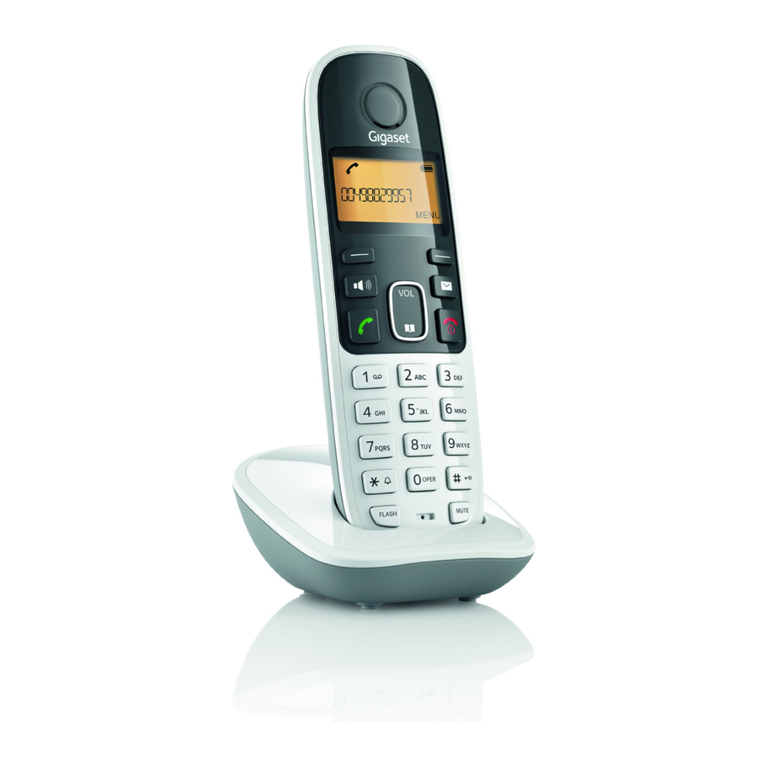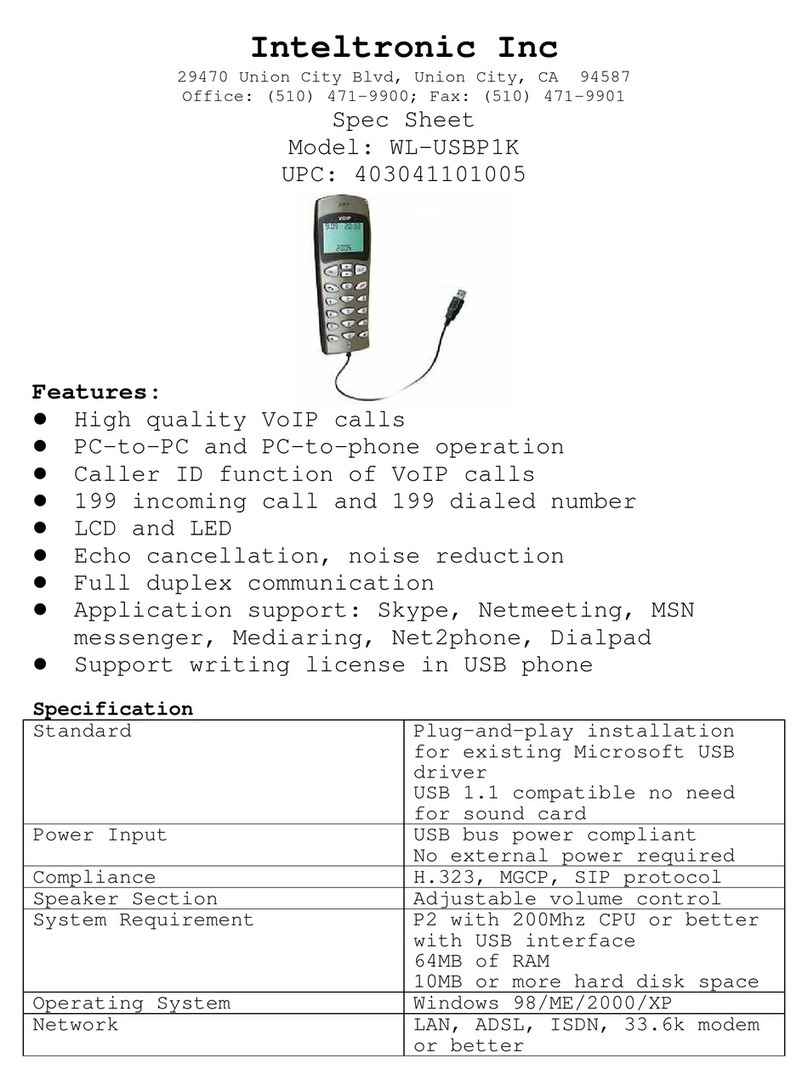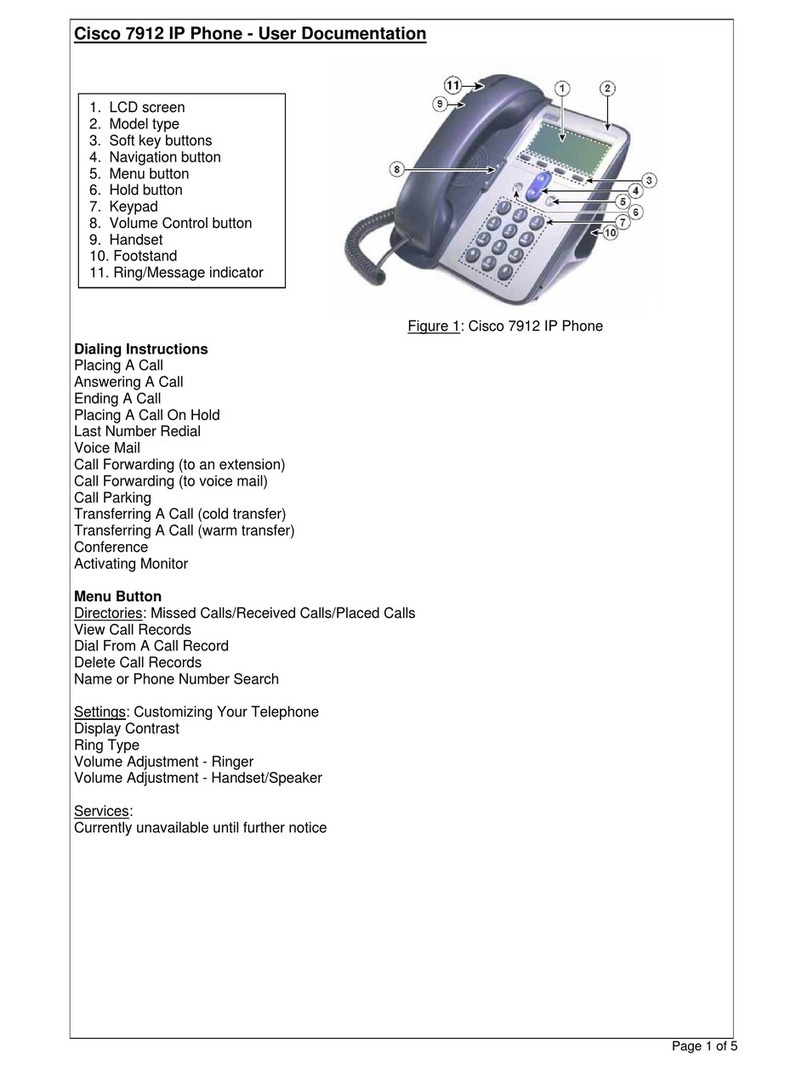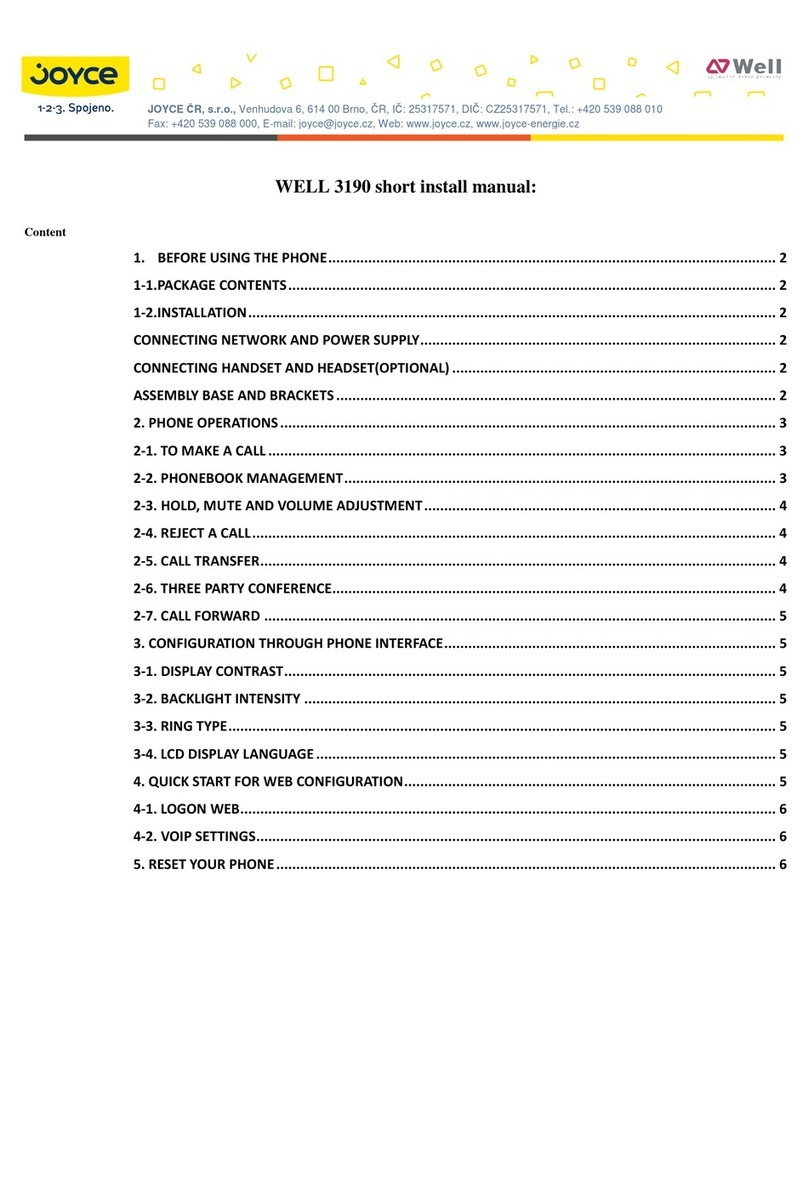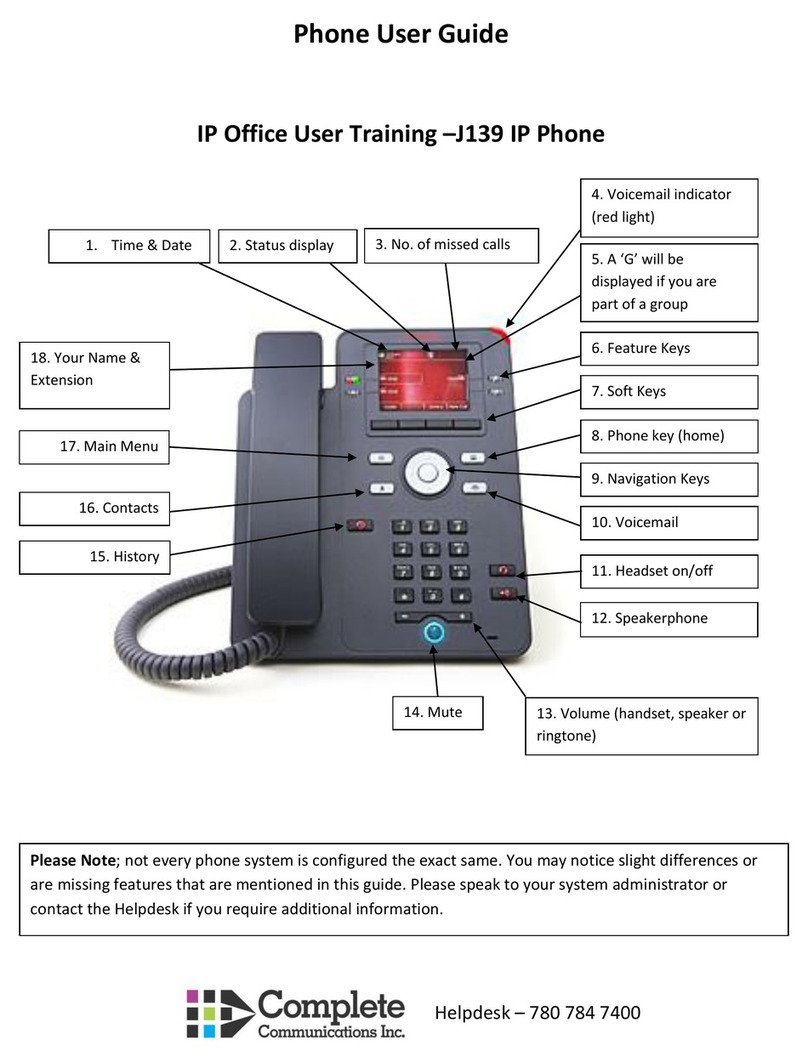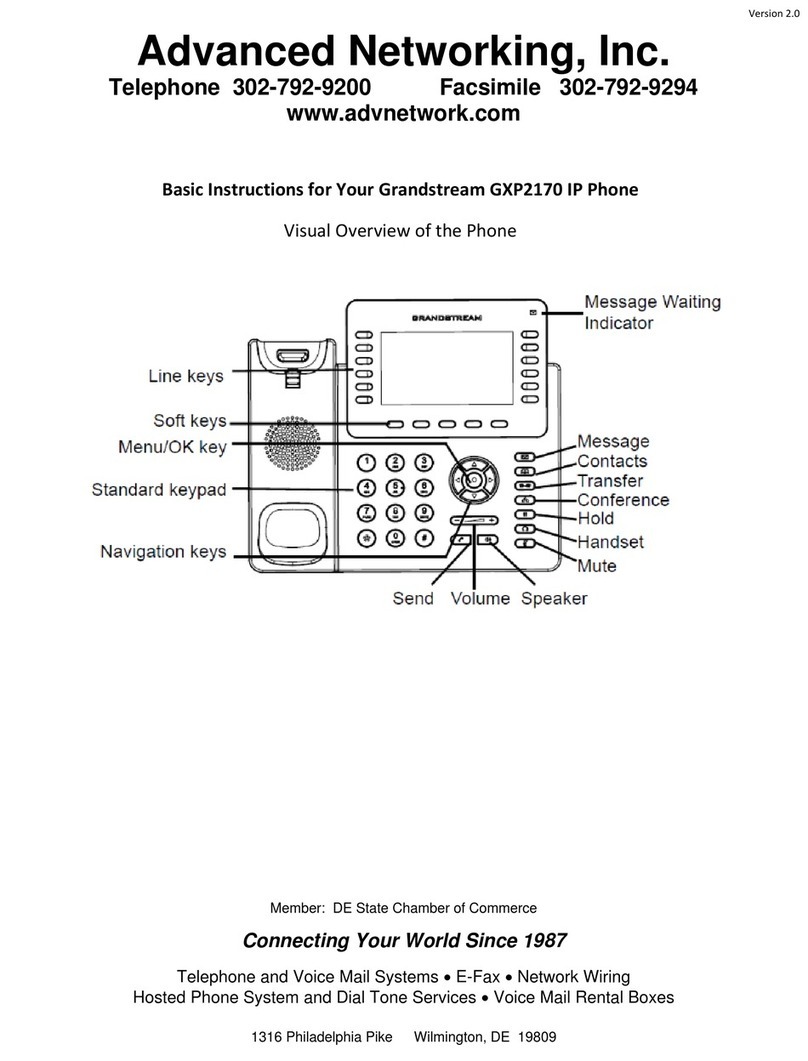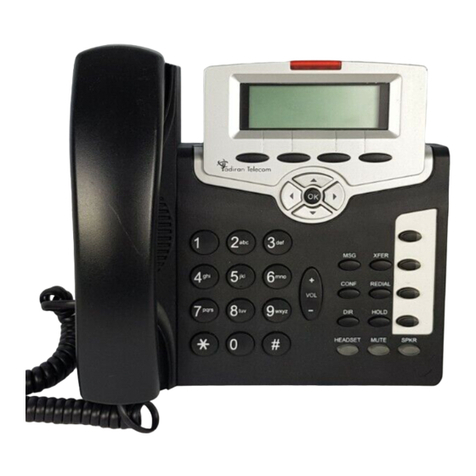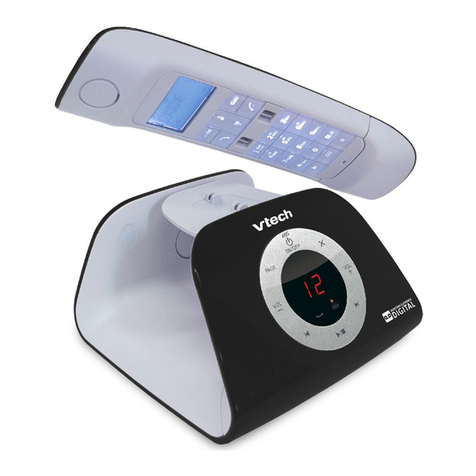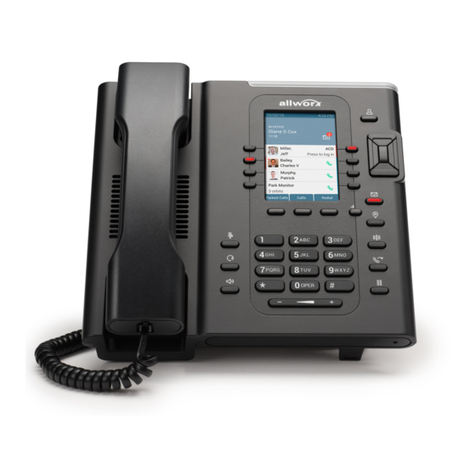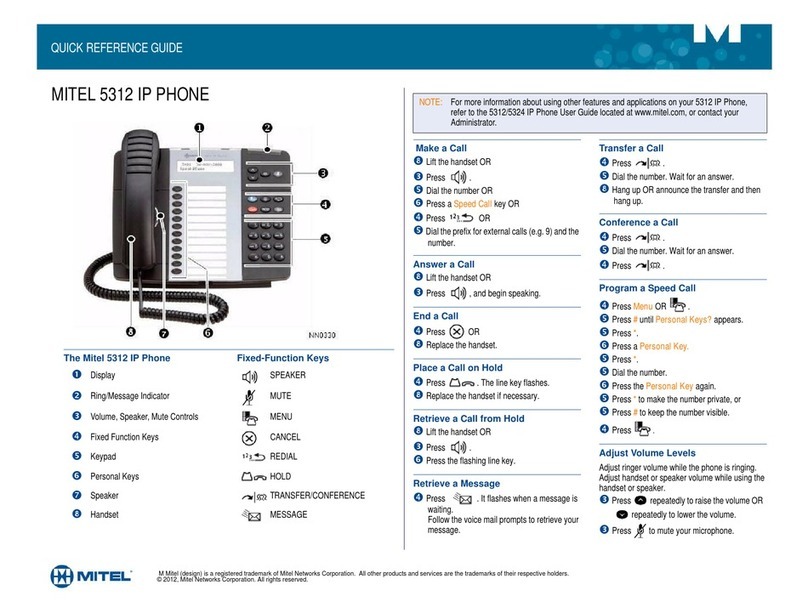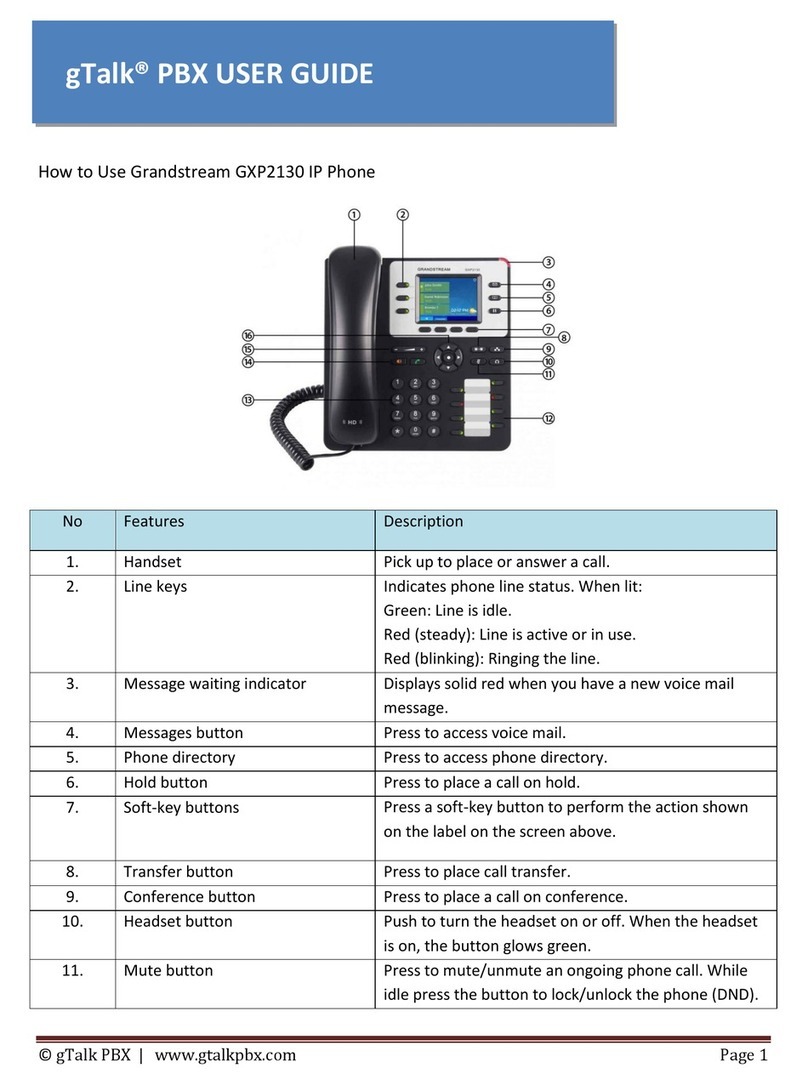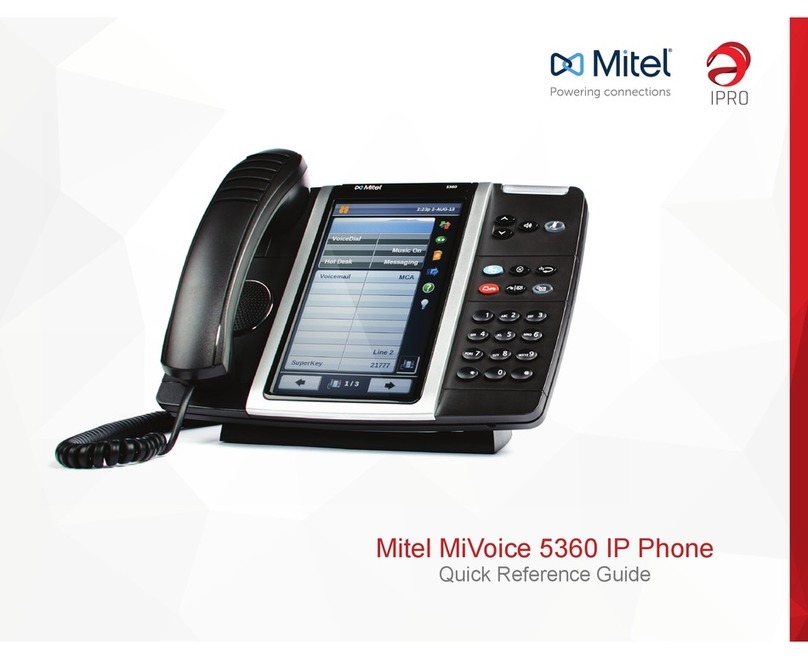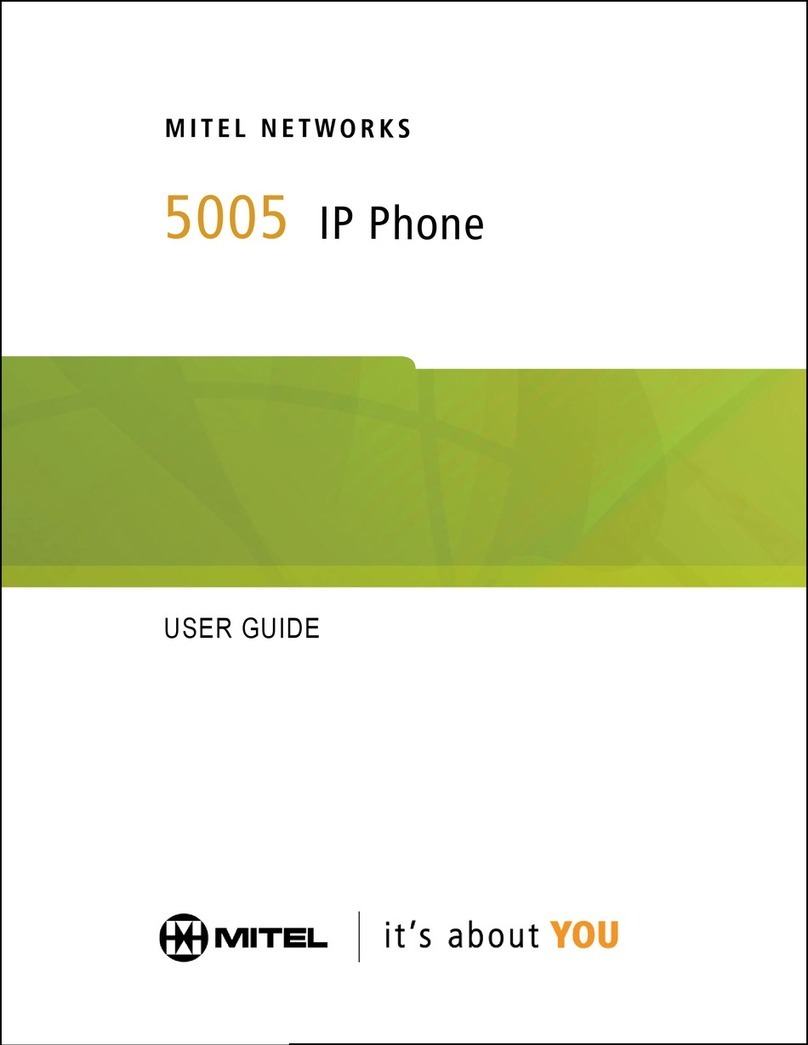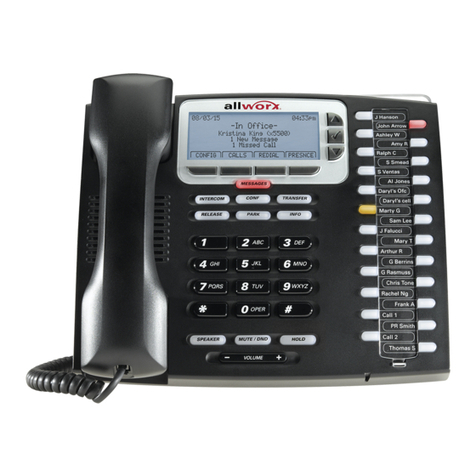Denwa Communications Mitel 5304 User manual

Mitel 5304 IP Phone:
User Guide
03303337323| www.denwa.uk.com
WINNER
MEDIUM SIZED
BUSINESS OF THE YEAR

Title space availble here. Title space availble here.
Title space availble here. Title space availble here.
Title space availble here. (Frutiger 57Cn 16pt)
MITEL
User Guide
5304 IP Phone
5000 Communications Platform (CP)


Mitel®5304 IP Phone User Guide – Issue 3, February 2011 Page iii
5304 IP Phone Quick Reference Guide
This guide provides information for frequently used features. For more information about these and other features,
refer to the user guide. For voice mail information, refer to the voice mail user guide for your system.
Programmable Buttons
The 5304 IP phone has nine programmable buttons.
When you first receive your phone, the buttons are pre-
programmed as indicated in the table below. You may
be able to reprogram the buttons for quick access to
features or frequently called phone numbers.
Button 1 is located just below the external speaker, and
button 9 is located just above the volume buttons.
Commonly Used Feature Codes
Most of the feature codes work when your phone is idle
or “on hook.” If you are on an active call or if you are off-
hook, you may need to press the Special button before
you enter the feature code to activate the feature.
Button Action
1 Special: Activates features while on a
call or off-hook.
2 DND: Enables/disables the DND
feature for your phone. When enabled,
internal calling parties see your
selected DND message.
3Forward: Forwards all incoming calls
to a specified destination.
4 Message: Connects to your voice
mailbox. Toggles between Alpha Mode
and Numeric Mode when entering
dialpad characters.
5Redial: Calls the last external number
dialed. You cannot redial internal
numbers.
6Transfer: Transfers the current call.
Also functions as a forward space
when entering dialpad characters.
7Hold: Places the current call on hold.
Also functions as a backspace button.
8 Intercom (IC): Provides a call line for
internal (intercom) calls.
9Call: Provides a call line for external
calls.
Up
Down Volume: Provide volume control for
the ringer, handset and speaker. Also
provides the ability to scroll through
display options.
Feature Code
ACD Agent – Log In/Out 328
Background Music – On/Off 313
Call Forward – All Calls 355
Call Logging 333
Conference 5
Default Station 394
Directory 307
Display Time And Date 300
Do-Not-Disturb – On/Off 372
Dynamic Express Extension On/Off 364
Dynamic Express Extension – Handoff 388
Hold – Individual 336
Hold – System 335
Hot Desk On/Off 348
Hunt Group – Remove/Replace 324
Message – Cancel Left Message 366
Message – Delete Message 368
Message – Leave Message 367
Message – View Messages Menu 365
Microphone Mute – On/Off 314
Page Receive – On/Off 325
Program Buttons 397
Program Station Passcode 392
Programmable Buttons – Default 395
Queue (Callback) Request 6
Record-A-Call 385
Reverse Transfer (Call Pick-Up) 4
Ring Tone Selection 398
Station Speed Dial 382
Station Speed Dial – Programming 383
Switch Keymap 399
System Forward – On/Off 354
System Speed Dial 381
View Button Assignments 396

Page iv Mitel®5304 IP Phone User Guide – Issue 3, February 2011
Answering Calls
Lift the handset to answer a call.
Placing Emergency Calls
Dial the emergency number (911 U.S. or
999/112 Europe). The system immediately places
the emergency call as soon as you dial the
number, even if you do not select an outside line.
Placing Internal (Intercom) Calls
Lift the handset and dial the extension number. If
you enter incorrect digits, you can press the Hold
button to move the cursor backward, deleting the
last digit entered.
Placing External Calls
Lift the handset, press the unlit Call button, and
then dial the number.
Redialing External Numbers
Lift the handset and press the Redial button. The
system automatically selects a line and dials the
number.
Transferring Calls to Other Extensions
1. While on the call, press the Transfer button, and
then enter the extension number.
2. Do one of the following:
Wait for an answer, announce the call, and
then hang up. If the extension is
unavailable, press the flashing IC or Call
button to return to the caller.
Hang up to transfer the call and disconnect
the call from your phone.
Forwarding Calls
1. Press the Forward button, and then enter the
feature code, if applicable. ENTER FORWARD
DEST appears.
2. Do one of the following:
Enter the extension number.
Dial the Outgoing Call access code (8is the
default code), and then dial the telephone
number.
Placing Ad Hoc Conference Calls
1. While on the first call, press the Special button
and then dial 5to place the call on hold. CALL
NEXT PARTY TO CNF appears.
2. Place a call to the next conference party. For
external calls, dial the Outgoing Call access code
(8is the default code), and then dial the number.
3. After the party answers, announce the
conference, and then press Special – 5 to place
the call on hold. If necessary, repeat this step to
add the remaining conference party.
4. Press Special – 5 again to start the conference.
CNF IN PROGRESS appears.
Viewing Messages
With the handset on-hook, press the Message
button. Messages are displayed as first in/first
out. If there is more than one message, you can
repeatedly press the Message button to scroll
through the messages.
Responding to Messages
When the desired message is displayed, lift the
handset, and then press # to respond. (If your
handset is off-hook and you press the Message
button, you automatically place a call to the party
who left the message or the message center.)
Using Do-Not-Disturb
1. With the handset on-hook, press the DND
button, and then do one of the following:
Press (Up) or (Down) to scroll
through the messages.
Enter the two-digit number for the DND
message.
2. After selecting the message, enter the additional
text for the DND description, if applicable.
3. Lift and replace the handset.
Placing a Page Announcement
1. Lift the handset, and dial 7.
2. Enter the page-zone number (0to 9).
3. After the tone, make your announcement, and
then hang up.

Mitel®5304 IP Phone User Guide – Issue 3, February 2011 Page v
Notice
This guide is released by Mitel Networks Corporation and provides information necessary to use the 5304 IP phone.
The guide contents, which reflect current Mitel standards, are subject to revision or change without notice.
Some features or applications mentioned may require a future release and are not available in the initial release.
Future product features and applications are subject to availability and cost. Some features or applications may
require additional hardware, software, or system administrator assistance.
For sales, service, or technical support, contact your local authorized provider:
If you do not know the contact information for your local provider, use the “Partners” link at the top of the Mitel home
page (www.mitel.com) to find a location near you.
If you have any questions or comments regarding this user guide or other technical documentation, contact the
Technical Publications Department (USA) at:
Mitel®is a registered trademark of Mitel Networks Corporation.
All other trademarks mentioned in this document are the property of their respective owners, including Mitel Networks
Corporation. All rights reserved.
© 2009-2011 Mitel Networks Corporation
Personal use of this material is permitted. However, permission to reprint/republish this material for advertising or
promotional purposes or for creating new collective works for resale or redistribution to servers or lists, or to reuse
any copyrighted component of this work in other works must be obtained from Mitel.
Enter provider information above.

Page vi Mitel®5304 IP Phone User Guide – Issue 3, February 2011
Important Safety Instructions and Precautions
Remember the following safety guidelines when using the IP phone.
Programming Emergency Numbers
Make sure to do the following when programming emergency numbers and/or making test calls to emergency
numbers:
Remain on the line and briefly explain to the dispatcher the reason for the call.
Perform tests during off-peak hours such as early morning or late evenings.
Safety Notices
The following notices may appear on the product or in the technical documentation.
Maintenance and Repair
There are no user serviceable parts inside the IP phone. For repairs, return the IP phone to an authorized Mitel
provider.
Notice Description
Caution indicates a potentially hazardous situation which, if not avoided, may result in minor
or moderate injury and/or damage to the equipment or property.
Warning indicates a potentially hazardous situation which, if not avoided, could result in
death or serious injury.
Danger indicates an imminently hazardous situation which, if not avoided, will result in death
or serious injury.
The exclamation point within an equilateral triangle indicates that important operating and
maintenance (servicing) instructions are included in the literature accompanying the
product.
NOTE Changes or modifications not expressly approved by Mitel may void the user’s right to operate the
equipment.

Mitel®5304 IP Phone User Guide – Issue 3, February 2011 Page vii
Power Requirements
The IP phone requires any one of the following power supplies:
Mitel 48-volt DC Ethernet power adaptor 100-240 volt AC 50-60Hz (ES) -part number 50005301
An industry-standard IEEE 802.3af Power over Ethernet (PoE) power supply unit
If your phone uses a centralized PoE power supply unit, do not use the 48-volt DC Ethernet power adaptor. If
necessary, contact your system administrator for assistance before connecting your phone to the centralized power
source.
Make sure the IP phone is plugged into an uninterruptible power supply (UPS). If your phone is plugged into the UPS
and the power fails, it should remain powered on for about 10 minutes. If the IP phone is not plugged into a UPS and
the power fails, the current call is dropped and you will not be able to use the IP phone until the power is restored.
Software Updates
The IP phone may require occasional software updates when new versions are available. The IP phone is configured
to download the updates automatically. Contact your system administrator for more information.
Product Disposal Instructions
This symbol indicates that the product is classified as electrical or electronic equipment and should not be disposed of with
other commercial or household waste at the end of its working life. For appropriate disposal and recycling instructions,
contact your local Mitel provider.
The Waste of Electrical and Electronic Equipment (WEEE) Directive (2002/96/EC) was established by the European Union to
minimize negative impact on the environment, control hazardous substances, and curtail landfill expansion by using the best
available recovery and recycling techniques.
CAUTION
IP Phone Damage Hazard. To avoid damaging the IP phone, make sure the IP phone is connected to the proper
power supply before powering on. Contact your system administrator for more information.
CAUTION
IP Phone Damage Hazard. Do not use your phone or disconnect it from the power supply while it is updating
software.

Page viii Mitel®5304 IP Phone User Guide – Issue 3, February 2011
IP Phone Usage
This equipment is not for connection to the telephone network or public coin phone service. It is only for use when
connected to Mitel systems.
WARNING
When using your phone equipment, basic safety precautions should always be followed to reduce the risk of
fire, electric shock and injury to persons, including the following:
Do not use this product near water, for example, near a bath tub, wash bowl, kitchen sink or laundry
tub, in a wet basement, or near a swimming pool.
Avoid using an IP phone (other than a cordless type) during an electrical storm. There may be a remote
risk of electric shock from lightning.
Do not use the IP phone to report a gas leak in the vicinity of a leak.
Do not connect directly to the Public Switched Telephone Network (PSTN). Any connection of this IP
phone to an off premise application, an out of plant application, any other exposed plant application, or
to any equipment other than the intended application may result in a safety hazard, and/or defective
operation, and/or equipment damage. “Exposed plant” means where any portion of the circuit is subject
to accidental contact with electric lighting or power conductors operating at a voltage exceeding 300
volts between conductors or is subject to lightning strikes.
The socket outlet, if used, shall be located near the equipment and shall be easily located by the user.
Use only Mitel approved power adaptors.See “Power Requirements” on page vii.
The handset supplied with the IP phone is not certified for use with any other phone. Use of the
handset with any other phone may have the potential to cause hearing loss in the event of a lighting
strike on the outside plant wiring.

Mitel®5304 IP Phone User Guide – Issue 3, February 2011 Page ix
Notice to Canadian Customers
The Class B digital apparatus complies with Canadian ICES-003.
Notice to U.S. Customers
This equipment has been tested and found to comply with the limits for a Class B digital device, pursuant to Part 15 of
the FCC Rules. These limits are designed to provide reasonable protection against harmful interference in a
residential installation. This equipment generates, uses, and can radiate radio frequency energy and, if not installed
and used in accordance with the instructions, may cause harmful interference to radio communications. However,
there is no guarantee that interference will not occur in a particular installation. If this equipment does cause harmful
interference to radio or television reception, which can be determined by turning the equipment off and on, the user is
encouraged to try to correct the interference by one or more of the following measures:
Reorient or relocate the receiving antenna.
Increase the separation between the equipment and receiver.
Connect the equipment into an outlet on a circuit different from that to which the receiver is connected.
Consult the dealer or an experienced radio/TV technician for help.
Notice to European Customers
We, Mitel Networks LTD.
Of, Mitel Castlegate Business Park
Portskewett
Caldicot
NP26 5YR
UK
Declare that for the hereinafter mentioned product the presumption of
conformity with the applicable essential requirements of
DIRECTIVE 1999/5/EC OF THE EUROPEAN
PARLIAMENT (RTTE DIRECTIVE) AND OF THE COUNCIL is given.
Mitel IP Phone: 5304
Any unauthorized modification of the product voids this Declaration.
For a copy of the original signed Declaration of Conformity (in full conformance with EN45014), please contact the Regulatory
Approvals Manager at the above address.


Contents
Mitel®5304 IP Phone User Guide – Issue 3, February 2011 Page xi
Contents
Getting Started 1
Welcome. . . . . . . . . . . . . . . . . . . . . . . . . . . . . . . . . . . . . . . . . . . . . . . . . . . . . . . . . . . . . . . . . . . . . . . 1
About Your IP Phone. . . . . . . . . . . . . . . . . . . . . . . . . . . . . . . . . . . . . . . . . . . . . . . . . . . . . . . . . . . . . 1
5304 Features . . . . . . . . . . . . . . . . . . . . . . . . . . . . . . . . . . . . . . . . . . . . . . . . . . . . . . . . . . . . . . . 2
Phone Feature Descriptions. . . . . . . . . . . . . . . . . . . . . . . . . . . . . . . . . . . . . . . . . . . . . . . . . . . . . 3
Phone Signals . . . . . . . . . . . . . . . . . . . . . . . . . . . . . . . . . . . . . . . . . . . . . . . . . . . . . . . . . . . . . . . . . . 5
Comfort and Safety Tips . . . . . . . . . . . . . . . . . . . . . . . . . . . . . . . . . . . . . . . . . . . . . . . . . . . . . . . . . . 5
Headset Instructions . . . . . . . . . . . . . . . . . . . . . . . . . . . . . . . . . . . . . . . . . . . . . . . . . . . . . . . . . . . . . 6
Personalizing Your Phone 7
Installing Designation Cards . . . . . . . . . . . . . . . . . . . . . . . . . . . . . . . . . . . . . . . . . . . . . . . . . . . . . . 7
Changing Volume Levels . . . . . . . . . . . . . . . . . . . . . . . . . . . . . . . . . . . . . . . . . . . . . . . . . . . . . . . . . 7
Changing the Ring Tone . . . . . . . . . . . . . . . . . . . . . . . . . . . . . . . . . . . . . . . . . . . . . . . . . . . . . . . . . . 8
Listening to Background Music . . . . . . . . . . . . . . . . . . . . . . . . . . . . . . . . . . . . . . . . . . . . . . . . . . . . 8
Changing the Language . . . . . . . . . . . . . . . . . . . . . . . . . . . . . . . . . . . . . . . . . . . . . . . . . . . . . . . . . . 8
Adjusting the Display Contrast . . . . . . . . . . . . . . . . . . . . . . . . . . . . . . . . . . . . . . . . . . . . . . . . . . . . 9
Using the Dialpad Buttons to Enter Characters . . . . . . . . . . . . . . . . . . . . . . . . . . . . . . . . . . . . . . 10
Using Programmable Buttons . . . . . . . . . . . . . . . . . . . . . . . . . . . . . . . . . . . . . . . . . . . . . . . . . . . . 12
Default Access Codes . . . . . . . . . . . . . . . . . . . . . . . . . . . . . . . . . . . . . . . . . . . . . . . . . . . . . . . . 13
Default Feature Codes. . . . . . . . . . . . . . . . . . . . . . . . . . . . . . . . . . . . . . . . . . . . . . . . . . . . . . . . 13
Viewing Button Assignments . . . . . . . . . . . . . . . . . . . . . . . . . . . . . . . . . . . . . . . . . . . . . . . . . . . . . 16
Resetting Programmable Buttons . . . . . . . . . . . . . . . . . . . . . . . . . . . . . . . . . . . . . . . . . . . . . . . . . 16
Resetting the Phone to the Default Settings. . . . . . . . . . . . . . . . . . . . . . . . . . . . . . . . . . . . . . . . . 16
Switching Keymaps. . . . . . . . . . . . . . . . . . . . . . . . . . . . . . . . . . . . . . . . . . . . . . . . . . . . . . . . . . . . . 16
Activating Door Relay . . . . . . . . . . . . . . . . . . . . . . . . . . . . . . . . . . . . . . . . . . . . . . . . . . . . . . . . . . . 17
Answering and Placing Calls 19
Answering Calls. . . . . . . . . . . . . . . . . . . . . . . . . . . . . . . . . . . . . . . . . . . . . . . . . . . . . . . . . . . . . . . . 19
Answering Waiting Calls . . . . . . . . . . . . . . . . . . . . . . . . . . . . . . . . . . . . . . . . . . . . . . . . . . . . . . 19
Using Automatic Call Access. . . . . . . . . . . . . . . . . . . . . . . . . . . . . . . . . . . . . . . . . . . . . . . . . . . 19
Redirecting Calls . . . . . . . . . . . . . . . . . . . . . . . . . . . . . . . . . . . . . . . . . . . . . . . . . . . . . . . . . . . . 19
Using Automatic Trunk Answer . . . . . . . . . . . . . . . . . . . . . . . . . . . . . . . . . . . . . . . . . . . . . . . . . . . 20

Contents
Page xii Mitel®5304 IP Phone User Guide – Issue 3, February 2011
Placing Calls . . . . . . . . . . . . . . . . . . . . . . . . . . . . . . . . . . . . . . . . . . . . . . . . . . . . . . . . . . . . . . . . . . 21
Placing Emergency Calls. . . . . . . . . . . . . . . . . . . . . . . . . . . . . . . . . . . . . . . . . . . . . . . . . . . . . . 21
Placing Internal Calls. . . . . . . . . . . . . . . . . . . . . . . . . . . . . . . . . . . . . . . . . . . . . . . . . . . . . . . . . 21
Placing External Calls . . . . . . . . . . . . . . . . . . . . . . . . . . . . . . . . . . . . . . . . . . . . . . . . . . . . . . . . 22
Redialing a Number. . . . . . . . . . . . . . . . . . . . . . . . . . . . . . . . . . . . . . . . . . . . . . . . . . . . . . . . . . 22
Using Speed Dial . . . . . . . . . . . . . . . . . . . . . . . . . . . . . . . . . . . . . . . . . . . . . . . . . . . . . . . . . . . . . . . 23
Using System Speed Dial . . . . . . . . . . . . . . . . . . . . . . . . . . . . . . . . . . . . . . . . . . . . . . . . . . . . . 23
Using Station Speed Dial. . . . . . . . . . . . . . . . . . . . . . . . . . . . . . . . . . . . . . . . . . . . . . . . . . . . . . 23
Using the Directory . . . . . . . . . . . . . . . . . . . . . . . . . . . . . . . . . . . . . . . . . . . . . . . . . . . . . . . . . . . . . 26
Using Account Codes . . . . . . . . . . . . . . . . . . . . . . . . . . . . . . . . . . . . . . . . . . . . . . . . . . . . . . . . . . . 27
Call Features 29
Using Ring Intercom Always . . . . . . . . . . . . . . . . . . . . . . . . . . . . . . . . . . . . . . . . . . . . . . . . . . . . . 29
Using Mute . . . . . . . . . . . . . . . . . . . . . . . . . . . . . . . . . . . . . . . . . . . . . . . . . . . . . . . . . . . . . . . . . . . . 29
Placing Calls On Hold . . . . . . . . . . . . . . . . . . . . . . . . . . . . . . . . . . . . . . . . . . . . . . . . . . . . . . . . . . . 30
Entering a Hookflash. . . . . . . . . . . . . . . . . . . . . . . . . . . . . . . . . . . . . . . . . . . . . . . . . . . . . . . . . . . . 30
Transferring Calls . . . . . . . . . . . . . . . . . . . . . . . . . . . . . . . . . . . . . . . . . . . . . . . . . . . . . . . . . . . . . . 31
Using Reverse Transfer. . . . . . . . . . . . . . . . . . . . . . . . . . . . . . . . . . . . . . . . . . . . . . . . . . . . . . . . . . 31
Viewing Your System Information . . . . . . . . . . . . . . . . . . . . . . . . . . . . . . . . . . . . . . . . . . . . . . . . . 32
Viewing Caller ID Information. . . . . . . . . . . . . . . . . . . . . . . . . . . . . . . . . . . . . . . . . . . . . . . . . . . . . 32
Forwarding Calls . . . . . . . . . . . . . . . . . . . . . . . . . . . . . . . . . . . . . . . . . . . . . . . . . . . . . . . . . . . . . . . 33
Manual Call Forwarding. . . . . . . . . . . . . . . . . . . . . . . . . . . . . . . . . . . . . . . . . . . . . . . . . . . . . . . 33
System Forwarding . . . . . . . . . . . . . . . . . . . . . . . . . . . . . . . . . . . . . . . . . . . . . . . . . . . . . . . . . . 33
Using Dynamic Extension Express . . . . . . . . . . . . . . . . . . . . . . . . . . . . . . . . . . . . . . . . . . . . . . . . 34
Using the Handoff - Push/Pull Feature . . . . . . . . . . . . . . . . . . . . . . . . . . . . . . . . . . . . . . . . . . . 35
Receiving Message Waiting Indications . . . . . . . . . . . . . . . . . . . . . . . . . . . . . . . . . . . . . . . . . . 36
Placing Ad Hoc Conference Calls . . . . . . . . . . . . . . . . . . . . . . . . . . . . . . . . . . . . . . . . . . . . . . . . . 37
Adding a Conference Party . . . . . . . . . . . . . . . . . . . . . . . . . . . . . . . . . . . . . . . . . . . . . . . . . . . . 37
Transferring a Conference. . . . . . . . . . . . . . . . . . . . . . . . . . . . . . . . . . . . . . . . . . . . . . . . . . . . . 37
Dropping Out of a Conference. . . . . . . . . . . . . . . . . . . . . . . . . . . . . . . . . . . . . . . . . . . . . . . . . . 37
Ending a Conference and Placing all Parties on Hold. . . . . . . . . . . . . . . . . . . . . . . . . . . . . . . . 38
Using Meet-Me Conferencing . . . . . . . . . . . . . . . . . . . . . . . . . . . . . . . . . . . . . . . . . . . . . . . . . . . . . 39
Conference Assistant. . . . . . . . . . . . . . . . . . . . . . . . . . . . . . . . . . . . . . . . . . . . . . . . . . . . . . . . . 39
Access Codes . . . . . . . . . . . . . . . . . . . . . . . . . . . . . . . . . . . . . . . . . . . . . . . . . . . . . . . . . . . . . . 39
Setting Up a Meet-Me Conference . . . . . . . . . . . . . . . . . . . . . . . . . . . . . . . . . . . . . . . . . . . . . . 39
Joining a Meet-Me Conference . . . . . . . . . . . . . . . . . . . . . . . . . . . . . . . . . . . . . . . . . . . . . . . . . 40
Dropping Out of a Meet-Me Conference . . . . . . . . . . . . . . . . . . . . . . . . . . . . . . . . . . . . . . . . . . 40
Putting a Meet-Me Conference on Hold. . . . . . . . . . . . . . . . . . . . . . . . . . . . . . . . . . . . . . . . . . . 40
Transferring a Meet-Me Conference . . . . . . . . . . . . . . . . . . . . . . . . . . . . . . . . . . . . . . . . . . . . . 40

Contents
Mitel®5304 IP Phone User Guide – Issue 3, February 2011 Page xiii
Using Record-A-Call . . . . . . . . . . . . . . . . . . . . . . . . . . . . . . . . . . . . . . . . . . . . . . . . . . . . . . . . . . . . 41
Using Group Listen . . . . . . . . . . . . . . . . . . . . . . . . . . . . . . . . . . . . . . . . . . . . . . . . . . . . . . . . . . . . . 42
Using Call Logging . . . . . . . . . . . . . . . . . . . . . . . . . . . . . . . . . . . . . . . . . . . . . . . . . . . . . . . . . . . . . 42
Using Secondary Extension Buttons. . . . . . . . . . . . . . . . . . . . . . . . . . . . . . . . . . . . . . . . . . . . . . . 43
Using Hot Desking. . . . . . . . . . . . . . . . . . . . . . . . . . . . . . . . . . . . . . . . . . . . . . . . . . . . . . . . . . . . . . 44
Using Configuration Assistant. . . . . . . . . . . . . . . . . . . . . . . . . . . . . . . . . . . . . . . . . . . . . . . . . . . . 45
Changing Your Station Passcode . . . . . . . . . . . . . . . . . . . . . . . . . . . . . . . . . . . . . . . . . . . . . . . 45
Accessing Configuration Assistant. . . . . . . . . . . . . . . . . . . . . . . . . . . . . . . . . . . . . . . . . . . . . . . 46
Changing the Dynamic Extension Express Settings . . . . . . . . . . . . . . . . . . . . . . . . . . . . . . . . . 46
Changing the DND Settings. . . . . . . . . . . . . . . . . . . . . . . . . . . . . . . . . . . . . . . . . . . . . . . . . . . . 47
Changing the Manual Call Forwarding Settings. . . . . . . . . . . . . . . . . . . . . . . . . . . . . . . . . . . . . 47
Managing Meet-Me Conferencing Access Codes . . . . . . . . . . . . . . . . . . . . . . . . . . . . . . . . . . . 48
Using Remote Programming . . . . . . . . . . . . . . . . . . . . . . . . . . . . . . . . . . . . . . . . . . . . . . . . . . . . . 49
Changing the Dynamic Extension Express Settings . . . . . . . . . . . . . . . . . . . . . . . . . . . . . . . . . 49
Changing the DND Settings. . . . . . . . . . . . . . . . . . . . . . . . . . . . . . . . . . . . . . . . . . . . . . . . . . . . 50
Changing the Manual Call Forwarding Settings. . . . . . . . . . . . . . . . . . . . . . . . . . . . . . . . . . . . . 50
Changing Your Station Passcode . . . . . . . . . . . . . . . . . . . . . . . . . . . . . . . . . . . . . . . . . . . . . . . 51
Messages 53
Leaving Messages at Other Extensions . . . . . . . . . . . . . . . . . . . . . . . . . . . . . . . . . . . . . . . . . . . . 53
Viewing and Responding to Messages . . . . . . . . . . . . . . . . . . . . . . . . . . . . . . . . . . . . . . . . . . . . . 54
Canceling Messages Left at Other Extensions . . . . . . . . . . . . . . . . . . . . . . . . . . . . . . . . . . . . . 54
Deleting Waiting Inter-Station Messages. . . . . . . . . . . . . . . . . . . . . . . . . . . . . . . . . . . . . . . . . . 54
Using Do-Not-Disturb (DND). . . . . . . . . . . . . . . . . . . . . . . . . . . . . . . . . . . . . . . . . . . . . . . . . . . . . . 55
Using Reminder Messages. . . . . . . . . . . . . . . . . . . . . . . . . . . . . . . . . . . . . . . . . . . . . . . . . . . . . . . 56
Paging Other System Users . . . . . . . . . . . . . . . . . . . . . . . . . . . . . . . . . . . . . . . . . . . . . . . . . . . . . . 57
Placing a Page Announcement . . . . . . . . . . . . . . . . . . . . . . . . . . . . . . . . . . . . . . . . . . . . . . . . . 57
Enabling or Disabling the Paging Feature . . . . . . . . . . . . . . . . . . . . . . . . . . . . . . . . . . . . . . . . . 57
Hunt Groups 59
Logging in to ACD Hunt Groups . . . . . . . . . . . . . . . . . . . . . . . . . . . . . . . . . . . . . . . . . . . . . . . . . . 59
Logging out of ACD Hunt Groups . . . . . . . . . . . . . . . . . . . . . . . . . . . . . . . . . . . . . . . . . . . . . . . . . 60
Stopping the ACD Hunt Group Wrap-up Timer. . . . . . . . . . . . . . . . . . . . . . . . . . . . . . . . . . . . . . . 60
Other Hunt Group Features . . . . . . . . . . . . . . . . . . . . . . . . . . . . . . . . . . . . . . . . . . . . . . . . . . . . . . 61
Requesting Agent Help . . . . . . . . . . . . . . . . . . . . . . . . . . . . . . . . . . . . . . . . . . . . . . . . . . . . . . . 61
Diverting Hunt Group Calls . . . . . . . . . . . . . . . . . . . . . . . . . . . . . . . . . . . . . . . . . . . . . . . . . . . . 61

Contents
Page xiv Mitel®5304 IP Phone User Guide – Issue 3, February 2011
Hunt Group Supervisor Features. . . . . . . . . . . . . . . . . . . . . . . . . . . . . . . . . . . . . . . . . . . . . . . . . . 62
Accepting or Rejecting Agent Help Calls. . . . . . . . . . . . . . . . . . . . . . . . . . . . . . . . . . . . . . . . . . 62
Monitoring Calls. . . . . . . . . . . . . . . . . . . . . . . . . . . . . . . . . . . . . . . . . . . . . . . . . . . . . . . . . . . . . 62
Stealing Hunt Group Calls . . . . . . . . . . . . . . . . . . . . . . . . . . . . . . . . . . . . . . . . . . . . . . . . . . . . . 62
Using Barge-In. . . . . . . . . . . . . . . . . . . . . . . . . . . . . . . . . . . . . . . . . . . . . . . . . . . . . . . . . . . . . . 63
Troubleshooting 65
Contact Information. . . . . . . . . . . . . . . . . . . . . . . . . . . . . . . . . . . . . . . . . . . . . . . . . . . . . . . . . . . . . 65
Error Messages . . . . . . . . . . . . . . . . . . . . . . . . . . . . . . . . . . . . . . . . . . . . . . . . . . . . . . . . . . . . . . . . 65
Troubleshooting Tips . . . . . . . . . . . . . . . . . . . . . . . . . . . . . . . . . . . . . . . . . . . . . . . . . . . . . . . . . . . 66
Index 69

Mitel® 5304 IP Phone User Guide – Issue 3, February 2011 Page 1
Getting Started
GettingStarted
Welcome
The instructions in this guide are for using the Mitel®5304 Internet Protocol (IP) phone on the
Mitel 5000 Communications Platform (CP). The 5304 IP Phone Quick Reference Guide located
at the beginning of this guide is an overview of frequently used features.
Your IP phone should be powered on and ready to use. If the display is blank, or if the display
name, extension number, or time or date are incorrect, contact your system administrator for
assistance.
Because a variety of voice mail products work with the Mitel 5000 CP, this guide does not
include voice mail instructions. For voice mail instructions, refer to the voice mail user guide for
your system. For example, refer to the Enterprise Messaging, Unified Voice Messaging, and
Embedded Voice Mail Card User Guide, part number 835.3205, or the Mitel NuPoint Unified
Messaging User Guide on the Mitel Web site (http://edocs.mitel.com). Contact your system
administrator for more information about your voice mail system.
About Your IP Phone
The Mitel 5304 IP phone is a compact, feature-rich phone that provides voice communication
over an IP network. The 5304 has a back-lit liquid crystal display (LCD), display-assisted feature
access, and a Ring/Message Indicator. In addition, for one-touch feature access, the 5304 has
nine programmable buttons.
NOTE Because many IP phone features can be programmed to perform various tasks,
some features may work differently than the descriptions in this guide. Contact
your system administrator for more information.

Getting Started
Page 2 Mitel® 5304 IP Phone User Guide – Issue 3, February 2011
5304 Features
The 5304 is shown here. See “Phone Feature Descriptions” on page 3 for more information
about the IP phone features.
1 – Liquid Crystal Display (LCD) 5 – Programmable buttons
2 – Ring/Message Indicator 6 – Volume buttons
3 – External speaker 7 – Dialpad buttons
4 – Handset 8 – Hookswitch
1
23
4
5
7
6
8

Mitel® 5304 IP Phone User Guide – Issue 3, February 2011 Page 3
Getting Started
Phone Feature Descriptions
The following sections describe default configurations. Your phone may be programmed
differently. Contact your system administrator for more information. See “5304 Features” on
page 2 for phone feature locations.
Display
The display provides a two-line, 20-character viewing area for using features and identifying
callers. When idle, the display shows your user extension, name, and the time and date.
Ring/Message Indicator
The Ring/Message Indicator flashes or stays lit to indicate call, message, and feature activity.
For more information about messaging features, see “Messages” on page 53. Ring/Message
Indicator signals are described in the following table.
Speaker
The 5304 speaker provides incoming audio. You can use the speaker to listen to calls or
background music. See “Viewing Button Assignments” on page 16 for more information about
background music.
The 5304 does not have an external microphone. Therefore, if you want to respond to a caller,
you must use the handset.
Handset and Hookswitch
The handset provided with this equipment is hearing aid compatible (HAC). One end of the
handset cord plugs into the handset and the other end plugs into the handset jack on the
phone. The hookswitch is located under the handset. When the handset is in the cradle, the
hookswitch is engaged and the phone is “on hook.” When you lift the handset, the hookswitch is
disengaged and the phone is “off hook.”
Most of the feature codes work when your phone is idle or “on hook.” Because the dialpad
buttons are located under the handset, you may find it easier to lift the handset, press the
hookswitch down, and then dial the feature code.
If you are on an active call or if you are off hook, you may need to press the Special button
before you enter the feature code to activate the feature.
Indicator Signals Description
Rapidly flashing You have an incoming call.
Slowly flashing You have a waiting message or callback message.
On You are on a call or using a feature.
Off Your phone is idle.

Getting Started
Page 4 Mitel® 5304 IP Phone User Guide – Issue 3, February 2011
Programmable Buttons
The 5304 has nine programmable buttons. When you first receive your phone, the buttons are
pre-programmed as indicated in the table below.
You may be able to reprogram the buttons for quick access to features or frequently called
phone numbers. See “Using Programmable Buttons” on page 12 for instructions. After
reprogramming the buttons, replace the phone’s original designation card with a new card that
reflects the reprogrammed buttons. See “Installing Designation Cards” on page 7.
Location Button and Default Feature/Function
1 – Special: Activates features while on a call or off-hook.
The Special button does not cancel features. To cancel
features, press the star button (*).
2 – Do-Not-Disturb (DND): Enables/disables the DND
feature for your phone. When enabled, internal calling parties
see your selected DND message. You can use DND to stop
calls and pages to your extension. See “Using Do-Not-Disturb
(DND)” on page 55.
3 – Forward: Forwards all incoming calls to a specified
destination. See “Forwarding Calls” on page 33.
4 – Message: Connects to your voice mailbox. Toggles
between Alpha Mode and Numeric Mode when entering
dialpad characters. See “Using the Dialpad Buttons to Enter
Characters” on page 10.
5 – Redial: Calls the last external number dialed. You cannot
redial internal numbers.
6 – Transfer: Transfers the current call. Also functions as a
forward space when entering dialpad characters. See “Using
the Dialpad Buttons to Enter Characters” on page 10.
7 – Hold: Places the current call on hold. Also functions as a
backspace button. See “Using the Dialpad Buttons to Enter
Characters” on page 10.
8 – Intercom: Provides a call line for internal (intercom) calls.
The Intercom button has a lamp, which flashes when an
internal call is ringing in, and is lit continuously during an
active call.
9 – Call: Provides a call line for external calls. The Call button
has a lamp which flashes when an external call is ringing in,
and is lit continuously during an active call.
9
8
7
6
5
4
3
2
1
Volume
Speaker
Designation
Label Buttons

Mitel® 5304 IP Phone User Guide – Issue 3, February 2011 Page 5
Getting Started
Volume Buttons
Directly below the programmable buttons, the 5304 has two volume buttons, (Up) and
(Down), that provide volume control for the ringer, handset and speaker. Volume levels are
automatically saved when you press the volume buttons.
In addition, these buttons allow you to scroll through display menus.
Dialpad Buttons
Use the dialpad buttons to dial phone numbers, enter feature codes, and to enter characters
when using features that require text input.
Phone Signals
The 5304 has several audio and visual signals to indicate feature activity. The following are a
few helpful tips:
Lit or blinking buttons indicate call or feature activity.
All phone button lamps illuminate at the same time for a few seconds when the phone is
reset or powered on.
The following actions may cause an error tone:
oPressing an invalid button combination.
oSelecting a restricted feature.
oDialing a restricted or invalid number.
oDialing too slowly between digits.
oWaiting too long before performing the next step.
To correct an error tone, hang up and try again.
Many features “time-out” if you wait too long before performing the next step. If this
happens, you must start over.
Comfort and Safety Tips
Observe the following comfort and safety tips when using the phone:
Do not cradle the handset: Prolonged use of the handset can lead to neck, shoulder, or
back discomfort, especially if you cradle the handset between your neck and shoulder.
Adjust the display:You can adjust the 5304 display to seven different positions to suit
your viewing needs. To adjust the display, grasp the display on the side and gently raise or
lower it into position.
Protect your hearing: Because prolonged exposure to loud sounds can contribute to
hearing loss, keep the volume at a moderate level. You can adjust the volume levels of the
handset receiver or headset. See “Changing Volume Levels” on page 7.
Table of contents
Other Denwa Communications IP Phone manuals
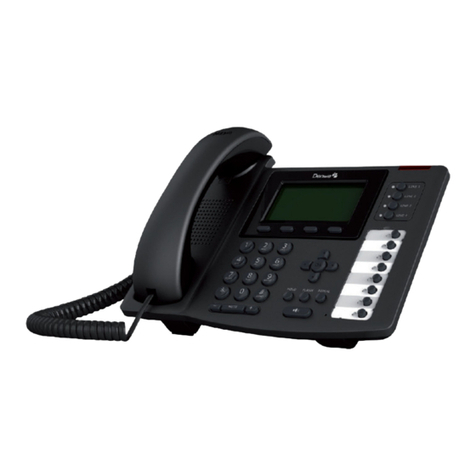
Denwa Communications
Denwa Communications DW-610P User manual
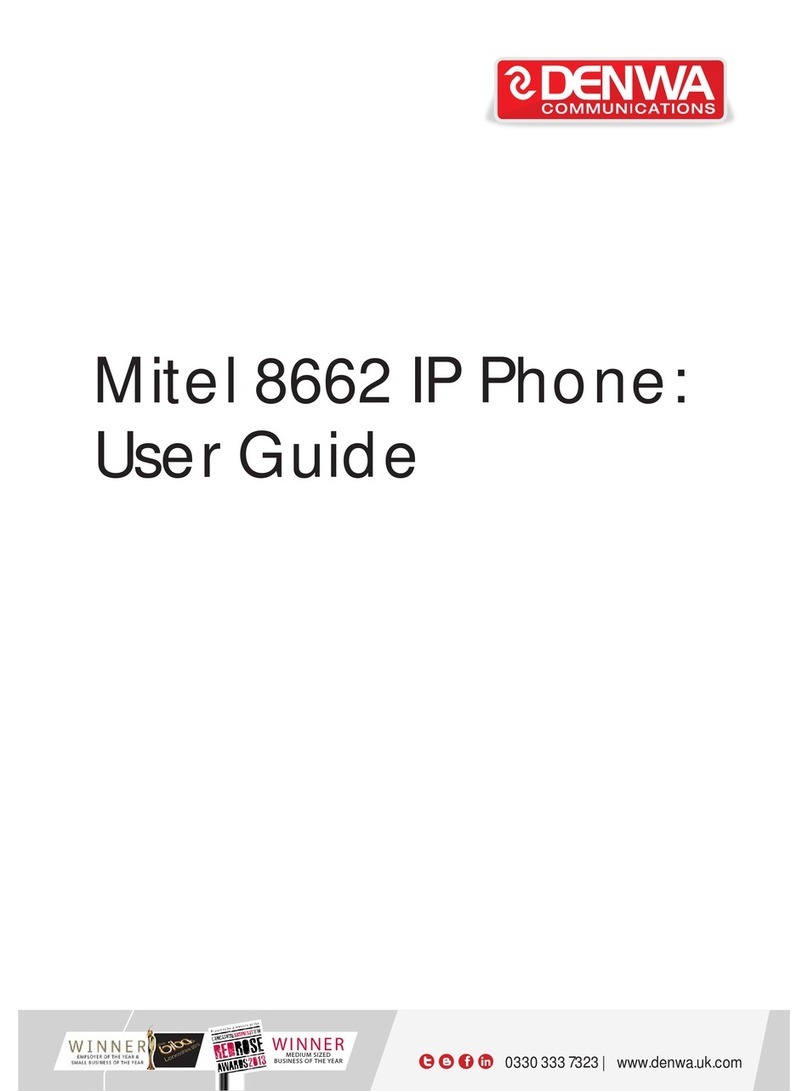
Denwa Communications
Denwa Communications Mitel 8662 User manual
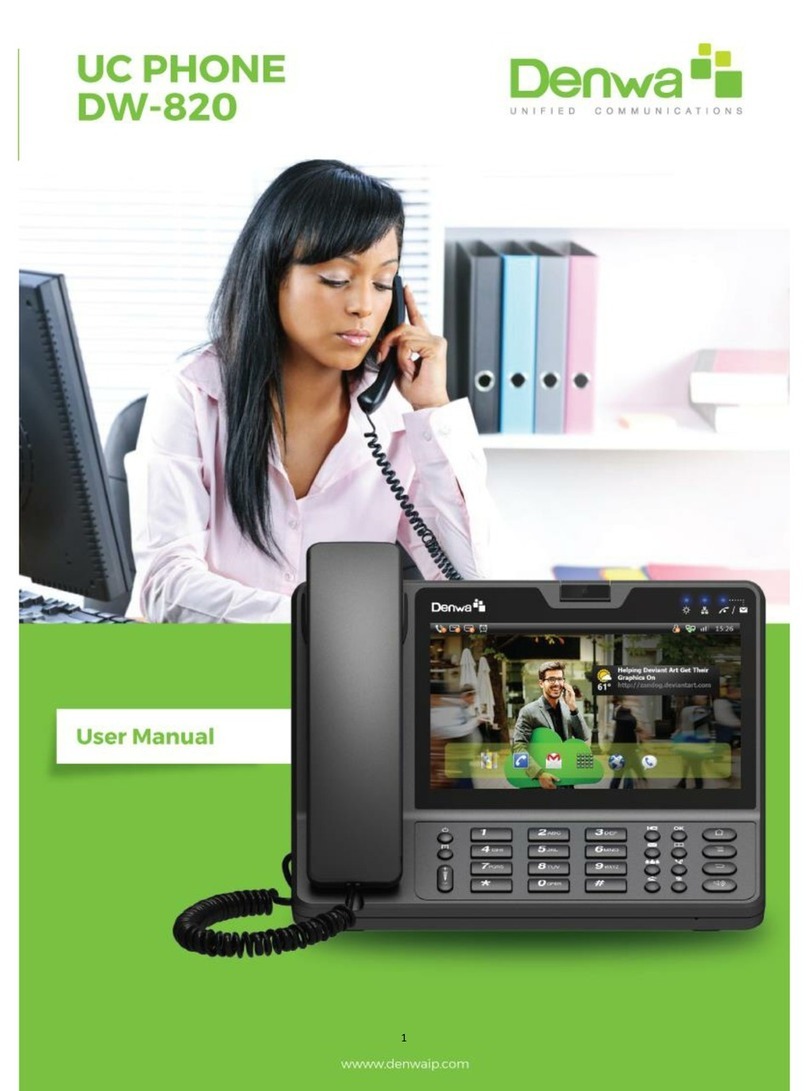
Denwa Communications
Denwa Communications DW-820 User manual

Denwa Communications
Denwa Communications DW-210P User manual

Denwa Communications
Denwa Communications DW-310P User manual
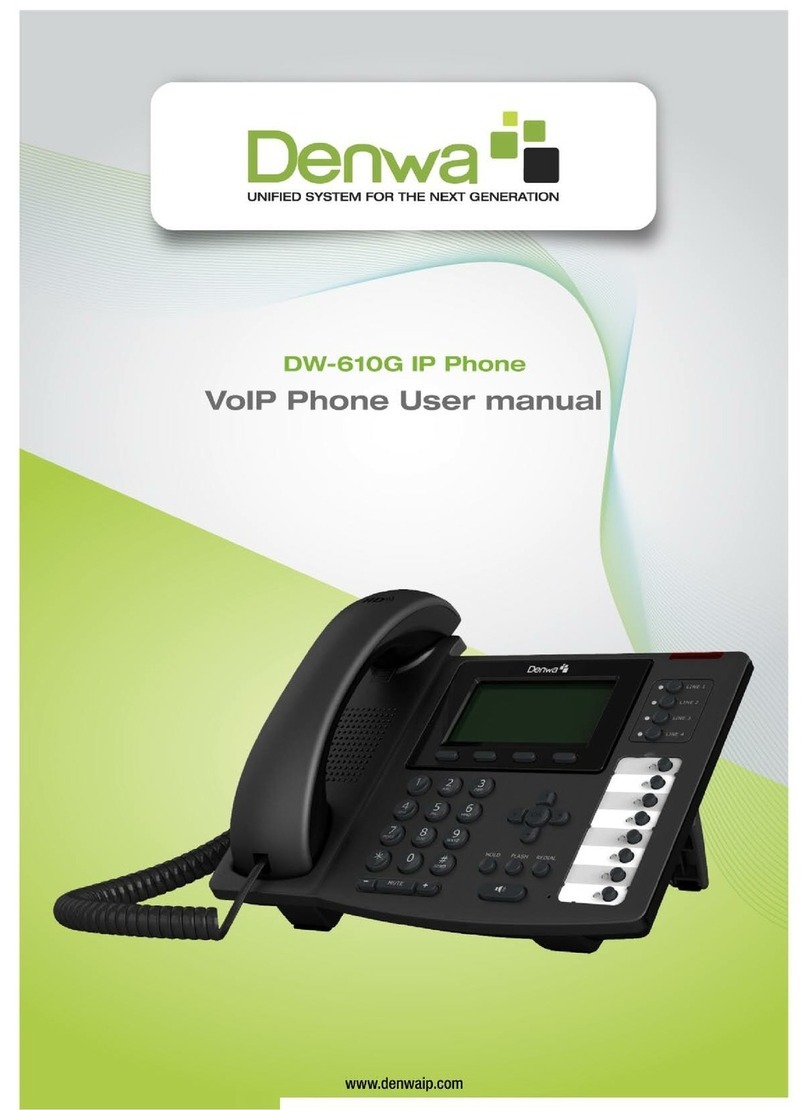
Denwa Communications
Denwa Communications DW-610G User manual
